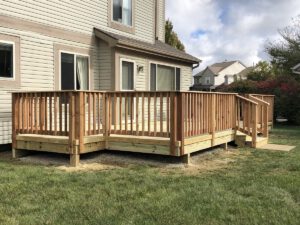When creating a sales deck for your business, there are several things to consider. For example, you should include the demographics of your most important customers, along with their revenue figures. It is also a good idea to break down these customers by gender, age, and location. This information will help you determine how to better reach your targeted customers.

Decks Charleston SC are flat surfaces that can support the weight. It is usually built outdoors, elevated from the ground, and connected to a building. The term derives from the deck of a ship. There are many different types of decking. The most popular types of decking are wood, metal, and composite.
A deck’s structure is built on the posts and beams that support it. The number of posts varies depending on the size of the deck and local building codes. There are also post caps that connect the top of the post to the underside of the beam and resist uplift forces. A deck’s sub-structure, which holds up the deck, is typically made of pressure-treated wood or metal.
The materials used for decking include hardwoods and softwoods. Hardwoods like mahogany are expensive and are often imported to the states from other parts of the world. However, environmentalists are questioning the legality of the practice of importing these hardwoods for use in decking. Other materials like teak are more affordable and beautiful.
The type of decking used can affect the aesthetic appeal of the deck. A 2×6 plank, for example, is typically 1-1/2″ thick and 6-inches wide, while a 5/4 plank is one inch thick and one-inches wide. Both types of decking are usually available in 8′, 10′, and 12′ lengths, though longer lengths are available for a premium.
Composite decking is another option for decking. These decking materials offer many benefits and are comparable to wood. However, composites tend to be less stiff and move more in response to changes in temperature. Therefore, it’s important to follow the manufacturer’s instructions carefully when installing them. They should also be installed using special fasteners that prevent the risk of bumps around the screw heads.
There are many choices when it comes to decking materials. You can choose to use pressure-treated wood, which is very common today, or you can choose to go with exotic hardwoods, which are hard and dense, resistant to rot, and also resistant to insects. Exotic hardwoods are expensive, but they are also beautiful and durable.
Pressure-treated lumber is a great option for decks because it’s rot-resistant and affordable compared to redwood. The downside is that you must treat it every year to protect it against pests and moisture. Despite this, pressure-treated wood can last up to 30 years. Depending on your preferences, you can choose stains or other finishing options to make your decking more attractive.
Some brands of composite decking are much cheaper than wood. These are often made from high-density polyethylene (HDPE) and wood particles, and they are an eco-friendly choice. However, they may not be as strong as wood and will move more in response to changes in temperature. You must also follow manufacturer instructions when installing composite decking, as composites are not as stable as wood.
If you’re unsure about the materials you should use for your deck, you can always compare them to each other. For example, redwood decking and composite decking are very similar, but there are some differences between them. For example, redwood is more expensive than treated lumber, but if you’re looking for something low-maintenance, composite decking might be perfect for you.
Composite decking is made from different materials, such as wood and HDPE. Some brands even use recycled materials. They don’t have a noticeable impact on the performance of the composite decking. Some of these products even use as much as 95% recycled materials.
There are a few key things to remember when planning the deck construction project. Firstly, you need to find out whether your community allows deck construction. Some have regulations that require certain heights or setbacks, and others have restrictions on structural support. In such cases, you should seek advice from your local building inspection office. Secondly, make sure that you get a written quote that includes all the costs and time frames.
